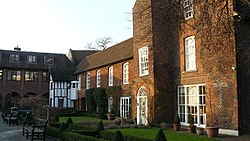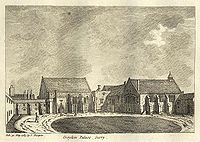Croydon Palace
| Croydon Palace | |
| Surrey | |
|---|---|
 Old Palace School | |
| Location | |
| Grid reference: | TQ32006545 |
| Location: | 51°22’22"N, 0°6’18"W |
| Town: | Croydon |
| History | |
| Country house | |
| Information | |
Croydon Palace is a country house in what is no longer countryside: it was the summer residence of the Archbishop of Canterbury for over 500 years. Regular visitors included Henry III and Queen Elizabeth I. Now known as "Old Palace", the buildings are still in use as the Old Palace School, an independent girls' school of the Whitgift Foundation.
The house is in Croydon in Surrey.
History

The Manor of Croydon was connected with the Archbishop of Canterbury from at least the late Saxon period, and records of buildings date back to before 960. The Palace as it now exists is a group of largely 15th and 16th century buildings, "an aggregate of buildings of different castes and ages", as the Archbishop Thomas Herring found it in 1754.[1] The 15th-century Great Hall is thought to have been installed by Archbishop John Stafford (d. 1452), with a late-14th-century two-storey porch and a vaulted ceiling to the lower chamber. The hall interior has a rich 16th-century timber roof and windows with interesting features such as the late Gothic interior porch. The Great Hall was partially remodelled in the 17th century by archbishops William Laud and William Juxon, who also rebuilt the chapel.
West of the Hall are the state apartments including the first-floor Guard Room, now the school library. The room is ascribed to Thomas Arundel (Archbishop 1396–1414), and has an arch-braced roof with carved stone supports and an oriel window. Other rooms have later panelling and fireplaces. The chapel has fine 17th-century stalls and an elaborate corner gallery. The fine altar rails are now in the Guard Room. The exterior of the whole palace is of stone or red brick, with early stone windows or Georgian sash windows.
The connection of the Archbishops with Croydon was of great importance, with several being important local benefactors. Six are buried in Croydon Minster, neighbouring the Palace: in date order they were Edmund Grindal, John Whitgift, Gilbert Sheldon, William Wake, John Potter and Thomas Herring. Archbishop Whitgift, who first called it a "palace", liked Croydon for "the sweetness of the place", though not all admired it, in the low-lying site which Henry VIII found "rheumatick", a place where he could not stay "without sickness". Sir Francis Bacon found it "an obscure and darke place" surrounded by its dense woodland.[2]
By the late 18th century, the Palace had become dilapidated and uncomfortable and the local area was squalid. An Act of Parliament enabled Croydon Palace to be sold and Addington Palace on the outskirts of Croydon to be bought in 1807. This became the new episcopal summer residence for much of the rest of the 19th century.
Legacy
The historic connection between Croydon and the archbishops is recognised in the names of several streets in Croydon which are named after the archbishops, including Whitgift Street, Grindall Close, Sheldon Street, Laud Street, Cranmer Road and Parker Road.
Outside links
| ("Wikimedia Commons" has material about Croydon Palace) |
References
Further reading
- Anderson, John Corbet (1879). The Archiepiscopal Palace at Croydon. London.
- Peter Drewett (1972). "The Archiepiscopal Palace at Croydon: a further contribution in the light of recent excavations". Archaeological Journal 128: 162–165.
- Ducarel, Andrew (1783). Some Account of the Town, Church, and Archiepiscopal Palace of Croydon. Bibliotheca Topographica Britannica. 12. London: J. Nichols. https://books.google.co.uk/books?id=YZtbAAAAQAAJ&printsec=frontcover&source=gbs_ge_summary_r&cad=0#v=onepage&q&f=false.
- Faulkner, P. A. (1970). "Some mediæval archiepiscopal palaces". Archaeological Journal 127: 130–146.
- Oswald, Arthur (1965). "The Old Palace, Croydon, Surrey: a former residence of the Archbishops of Canterbury". Country Life 137: 806–810, 876–80.
- Thornhill, Lilian (1987). From Palace to Washhouse: a study of the Old Palace, Croydon, from 1780–1887. Croydon Natural History and Scientific Society Proceedings. 17. Croydon: Croydon Natural History and Scientific Society. ISBN 0906047188.
- Walker, Yvonne M. (1990). The Story of Croydon Old Palace and the Archbishops of Canterbury 871–1780. Purley: AMCD Ltd & Croydon Libraries.
